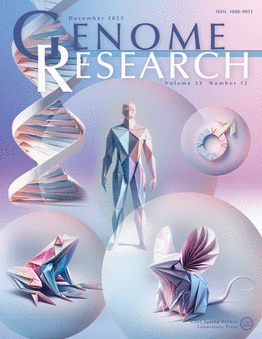优雅小鼠胚胎中 mRNA 衰减的时空分辨图谱揭示了不同阶段和细胞类型中 mRNA 稳定性的不同调控方式
IF 6.2
2区 生物学
Q1 BIOCHEMISTRY & MOLECULAR BIOLOGY
引用次数: 0
摘要
在胚胎发育过程中,细胞的基因表达会发生动态变化,而这种变化是适当的细胞命运分化所必需的。虽然转录和 mRNA 降解都有助于基因表达的动态变化,但人们对 mRNA 的衰变模式了解较少。在这里,我们通过抑制转录,然后进行大量和单细胞 RNA 测序,直接测量了整个秀丽隐杆线虫胚胎发生过程中转录组的时空分辨率 mRNA 降解率。这使我们能够计算特定细胞类型和发育阶段中的 mRNA 半衰期,并识别整个胚胎发育过程中受到不同调控的 mRNA 衰减。我们确定了与 mRNA 稳定性相关的转录本特征,并发现随着时间的推移,mRNA 的衰变率与基因表达的不同峰值相关。此外,我们还提供证据表明,平均而言,胚芽中的 mRNA 比胚体中的更稳定,胚胎晚期的 mRNA 比早期的更稳定。这项研究表明,不同细胞状态和不同时间的mRNA衰变有助于形成发育基因的表达,它为研究mRNA周转调控机制提供了宝贵的资源。本文章由计算机程序翻译,如有差异,请以英文原文为准。
A spatiotemporally resolved atlas of mRNA decay in the C. elegans embryo reveals differential regulation of mRNA stability across stages and cell types
During embryonic development, cells undergo dynamic changes in gene expression that are required for appropriate cell fate specification. Although both transcription and mRNA degradation contribute to gene expression dynamics, patterns of mRNA decay are less well-understood. Here we directly measured spatiotemporally resolved mRNA decay rates transcriptome-wide throughout C. elegans embryogenesis by transcription inhibition followed by bulk and single-cell RNA sequencing. This allowed us to calculate mRNA half-lives within specific cell types and developmental stages and identify differentially regulated mRNA decay throughout embryonic development. We identified transcript features that are correlated with mRNA stability and found that mRNA decay rates are associated with distinct peaks in gene expression over time. Moreover, we provide evidence that, on average, mRNA is more stable in the germline compared to in the soma and in later embryonic stages compared to in earlier stages. This work suggests that differential mRNA decay across cell states and time helps to shape developmental gene expression, and it provides a valuable resource for studies of mRNA turnover regulatory mechanisms.
求助全文
通过发布文献求助,成功后即可免费获取论文全文。
去求助
来源期刊

Genome research
生物-生化与分子生物学
CiteScore
12.40
自引率
1.40%
发文量
140
审稿时长
6 months
期刊介绍:
Launched in 1995, Genome Research is an international, continuously published, peer-reviewed journal that focuses on research that provides novel insights into the genome biology of all organisms, including advances in genomic medicine.
Among the topics considered by the journal are genome structure and function, comparative genomics, molecular evolution, genome-scale quantitative and population genetics, proteomics, epigenomics, and systems biology. The journal also features exciting gene discoveries and reports of cutting-edge computational biology and high-throughput methodologies.
New data in these areas are published as research papers, or methods and resource reports that provide novel information on technologies or tools that will be of interest to a broad readership. Complete data sets are presented electronically on the journal''s web site where appropriate. The journal also provides Reviews, Perspectives, and Insight/Outlook articles, which present commentary on the latest advances published both here and elsewhere, placing such progress in its broader biological context.
 求助内容:
求助内容: 应助结果提醒方式:
应助结果提醒方式:


